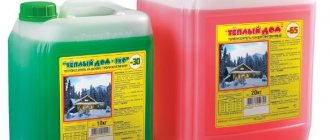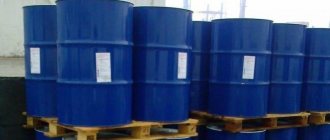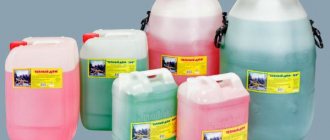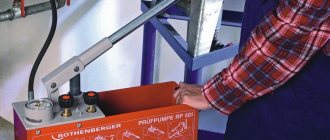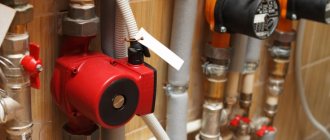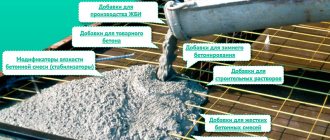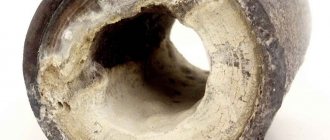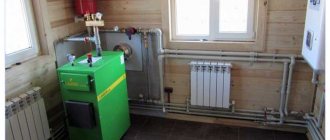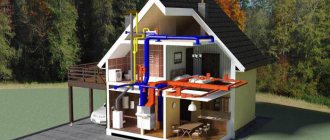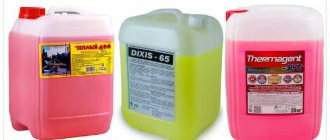Features of a water heating system
Propylene glycol in the heating system avoids corrosion and scale.
The composition includes a heating boiler, a pipeline network, batteries, a circulation pump, collectors, external temperature meters, thermostats. Water passes through the heat exchanger of the unit, heats up and flows through pipes into the radiators of the heated space. The energy carrier releases heat through the batteries and returns to the source. The coolant moves naturally or using a pump.
Heating in the house is:
- gravitational (natural);
- forced.
The work is controlled by sensors and thermal heads automatically or coordinated manually. In the system, the temperature is regulated separately on all devices, which saves fuel. The main line uses a propylene glycol-based coolant, this extends the service life of equipment and devices. There is no sediment deposited in the pipes, so 80–90% of the heat is transferred.
The disadvantage of water is that it freezes in unheated buildings, bursting collectors and radiators. Adding salt does not solve the problem, because it leads to increased corrosion; the inclusion of antifreeze in the coolant increases the cost of heating.
The difference between ethylene glycol and propylene glycol
Heating and cooling fluids based on ethylene glycol (ethanediol) are characterized by higher heat capacity and thermal conductivity compared to aqueous solutions of monopropylene glycol, and this allows the use of smaller radiators and heat exchangers in circuits. They also have a lower viscosity, which ensures better coolant circulation within the system and reduced hydrodynamic losses.
Due to the low viscosity of ethanediol, it is possible to create solutions of various concentrations with a maximum crystallization temperature of -70 ° C. There is also a main difference - ethylene glycol is almost 2 times cheaper than its competitor.
A significant disadvantage of ethylene glycol solutions is their toxicity. Their penetration into groundwater and soil is unacceptable, especially in places where groundwater is used and agricultural crops are grown. If used carelessly, antifreeze can enter the body, which can be fatal. The material also has a sweetish taste and does not have an unpleasant odor, which creates an increased danger for animals and children in case of leaks.
Description of propylene glycol
For a rarely visited country house, it is better to use a non-freezing liquid.
The substance is actively used in heating circuits due to its non-toxicity and safety. It is a viscous, colorless liquid with a characteristic odor, which is used in many industries.
Liquid properties:
- the solution can withstand temperatures from -40 to +100°C without changing the state; for a pure substance, operating parameters are in the range -60 to +185°C;
- the substance contains up to 5% carboxylates, which protect the inside of the pipe from destruction;
- Anti-corrosion, anti-scale and stabilizing additives are introduced into the composition of glycol for heating.
The density of propylene glycol is less than that of glycerin and ethylene glycol, but higher than that of ethanol. The viscosity of the substance is greater than that of alcohols and ethylene glycol, especially in cold conditions. The substance is produced from propylene oxide by hydration at +160 - +200°C under a pressure of 1.6 MPa.
The reaction takes place in a vacuum, and in the process the following is released:
- propylene glycol – 85%;
- dipropylene glycol – 13%;
- tripropylene glycol – 2%.
The finished product is stored for a year without changing its qualities. After this, the substance is divided into additives and a base, which reduces the heat capacity of propylene glycol.
Specifications
If you add 54% antifreeze to the coolant, the liquid will begin to freeze at minus 40 degrees.
The product is used as the basis for an energy carrier with which the system is not afraid of freezing. Inexpensive pipes can be used, since the substance contains anti-corrosion components.
Freezing point depending on the concentration of propylene glycol:
- contains 54% of the substance - the energy carrier freezes at -40°C;
- 48% – -30°С;
- 39% – -20°С;
- 25% – -15°С;
- 15% – -5°С.
In the system with the substance, storage boilers are used; in heating with ethylene glycol, the use of such units is not allowed according to the instructions. The disadvantage of propylene glycol, like ethylene glycol, is considered to be increased fluidity, due to which the liquid penetrates into crevices that are inaccessible to water. Welding seams and connections with fittings are carried out carefully to prevent leaks.
The coolant propylene glycol is used only in a system with the appropriate technical characteristics, so replacing water does not always lead to good results. Manufacturers of radiators indicate in the passport the conformity of products with certain types of energy carriers.
The product is miscible with water, alcohols, ethylene, acids, organic carbonyl group, amines and nitrogen-containing solutions.
Is it possible to mix different characteristics, for example G11 and G12
Here you already need to think, although again, nothing terrible will most likely happen. BUT you need to understand that there is a subgroup of G11 and G12, and there is a completely different option - G13.
If we take the first subgroup, then mixing will lead to the fact that the final liquid will contain both protective and anti-corrosion additives. Although you won't be able to control the mixing properly. Precipitation most likely will not form, BUT you need to understand that adding other additives not designed for your car, in particular radiators, can worsen cooling. WHY? YES because green antifreezes envelop the tubes with a film inside, which prevents the engine and other units from cooling. That is, if you suddenly added, say, green or blue antifreeze to red, then be prepared for the fact that the temperature may drop. All this will also happen and vice versa, if you add blue or green (G11) to red (G12), then the characteristics of the liquid also drop.
However, it is worth noting that if you added any minor volume, say up to 0.5 liters. The effect may not be visible at all. You'll just ride as usual and that's it.
Advantages and disadvantages
To prevent scale from forming, propylene glycol is mixed with distilled water.
In water at temperatures above +75°C, carbonates decompose and scale is deposited. Propylene glycol inhibits the corrosion process, ideally if the substance is added to a distilled liquid.
Advantages of using energy carrier with additives:
- protects the heating circuit and devices from rupture in frost, freezing occurs slowly with gradual crystal formation;
- the frozen substance in the pipes acquires a working consistency when the heating unit is started;
- the second most environmentally safe coolant after water, long-term inhalation of vapors, ingestion, contact with skin is not dangerous;
- does not damage materials upon contact with floor and wall finishes;
- promotes rapid heating and slow cooling of the system;
- reduces hydraulic resistance and improves the functioning of the pump in the return branch;
- reduces electricity consumption when pumping energy carriers, due to its low density.
Disadvantages include high cost compared to other types. But the high cost is justified by minimizing repairs, reducing the amount of fuel and labor costs. The substance is not used in heating lines where there are galvanized elements.
Applications of propylene glycol
As I wrote above, now many countries are switching to safe compounds, such as propylene glycol. Its characteristics are impressive. Based on it, there is now only one type of antifreeze G13, they come in purple and yellow .
What advantages does this liquid have:
- Even without water it has excellent temperature characteristics . From – 47 to + 106 degrees Celsius. If you add distilled water to it, the characteristics can be improved.
- Environmentally friendly . It does not pose a threat to humans and the environment, even if it is spilled, no negative effects on the skin or breathing will be noticed.
- Corrosion resistance. It practically does not corrode metals, plastics and rubber, and is not as active as its opponent.
- Almost non-flammable. The flammability of a pure liquid is present, but if you add only 10 - 15% water, it will not burn! Much safer in that regard.
Now it is practically the most advanced liquid. However, the disadvantages include the price; it costs almost twice as much as its brother. Therefore, antifreezes made with propylene glycol are more expensive, but of better quality.
Differences between propylene glycol and ethylene glycol
When ethylene glycol is heated, the liquid expands by 1.5%.
Ethylene glycol is an organic acid-containing solution, a representative of polyhydric alcohols. It is a colorless, transparent, odorless, oily liquid. Entering the body causes toxic poisoning.
Differences from propylene glycol:
- when freezing, the volume of water with propylene glycol increases by only 0.1%, and the coolant with ethylene glycol increases by 1.5%;
- the energy carrier with propylene glycol withstands the evaporation of water from solution and does not freeze down to -60°C, ethylene glycol crystallizes at -13°C, glycerin – +17°C;
- the toxicity of propylene glycol LD50 is from 20 to 30 thousand mg/kg, the same indicator for ethylene glycol is LD52 – 4700 mg/kg.
The toxic substance is quickly absorbed into the body, causing pulmonary edema and heart failure. The substance is not used in open systems, because it penetrates through the skin and through inhalation. The spent energy carrier based on ethylene glycol is not poured into the ground or sewer, but is sent for recycling.
Is it possible to mix ethylene glycol and propylene glycol?
They are very similar in their chemical compositions, but their properties are very different. What I mean:
You can mix them, but they are from the same homologous series (dihydric alcohols). Moreover, there will most likely be no sediment or other reactions! However, more advanced propylene glycol may lose its properties and acquire negative properties from its counterpart
That is, in simple words - propylene glycol, which is more technically advanced, safer, not so active (does not corrode metals as much), and also has improved temperature characteristics, will mix with the less advanced ethylene glycol and become simply worse and more toxic. BUT this is ideal. However, admit it - which of you and I mix pure substances? Usually they want to mix antifreezes, say G12 and G13 , but here it’s a slightly different story, because antifreezes have their own additives, which can easily be incompatible with each other, then a chemical reaction and the sediment itself, although it may not exist, just like in roulette 50/50!
Hence the moral - pure compounds can be mixed (but the characteristics of a more technologically advanced composition will decrease). But it is NOT advisable to mix antifreezes such as G12 and G13! But G11 and G12 are more similar in composition; their mixture is 80% harmless, because it is based on ethylene glycol.
Now let's watch a useful video.
That's all, read our AUTOBLOG.
( 8 votes, average: 4.50 out of 5)
Criterias of choice
The materials of the radiators must be compatible with the chemical composition of the coolant.
When determining the type, the operating temperature at which the energy carrier exists for a certain time without decomposition is taken into account. The properties of the liquids are described and allow you to select an additive based on the characteristics of the heating system.
Indicators taken into account:
- heat capacity shows the volume of energy carrier that will provide the required heat per unit of time;
- corrosion activity indicates the need to select pipes and batteries and the impossibility of use with some materials;
- viscosity determines the speed of movement of the liquid, affects leaks, heat transfer coefficient, the indicator changes when heated or cooled;
- The lubrication rate limits the use of certain materials and designs of various mechanisms in contact with the product.
What matters is safety for humans, the ability to cause burns and toxic poisoning. The flammability limit and the possibility of damage to objects when spilled from the system are taken into account.
